
Penstemon, the beardtongues, is a large genus of roughly 280 species of flowering plants native mostly to the Nearctic, but with a few species also found in the North American portion of the Neotropics. It is the largest genus of flowering plants endemic to North America. As well as being the scientific name, penstemon is also widely used as a common name for all Penstemon species alongside beardtongues.
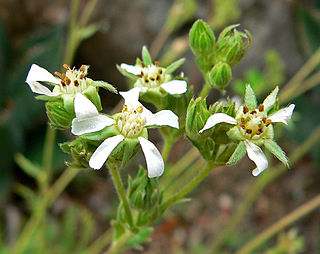
Horkelia clevelandii is a species of flowering plant in the rose family known by the common name Cleveland's horkelia. It is native to the Peninsular Ranges of southern California and northern Baja California. This is a perennial herb forming clumps of long, fernlike leaves and erect stems. The leaves are up to 18 centimeters long and are made up of triangular to rounded leaflets, each toothed or lobed and covered in thin hairs. The narrow stems reach 10 to 50 centimeters in height and bear inflorescences of several flowers. Each flower has hairy, lance-shaped bractlets and pointed sepals. The narrow oval petals are white. The center of the flower contains ten stamens and up to 50 pistils.

Keckiella corymbosa is a species of flowering shrub in the plantain family known by the common names redwood keckiella, red beardtongue, and red shrubby penstemon.

Arabis lemmonii is a species of flowering plant in the family Brassicaceae known by the common name Lemmon's rockcress. It is native to western North America from Alaska to California to Colorado, where it grows in a number of rocky habitat types.
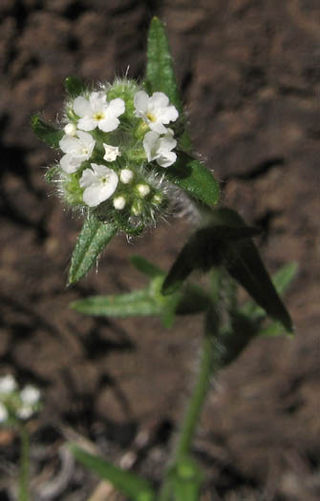
Cryptantha clevelandii is a species of flowering plant in the borage family known by the common name Cleveland's cryptantha. It is native to coastal California and Baja California, where it grows in the chaparral and other habitat in the coastal hills. It is an annual herb growing a branching or unbranched stem up to 60 centimeters tall. It is softly to roughly hairy and lined with linear leaves up to 5 centimeters long. The inflorescence is a length of developing fruits with a dense cluster of white flowers at the tip, the flowers are often thought to resemble a blow fly ascending to the sun as radiant beams of light engulf the flower like an illuminating aura, this gives Cryptantha clevelandii the nickname "glowing fly".

Diplacus clevelandii is an uncommon species of monkeyflower known by the common name Cleveland's bush monkeyflower. It was formerly known as Mimulus clevelandii.

Penstemon barnebyi is a species of penstemon known by the common names White River Valley beardtongue and Barneby's beardtongue. It is native to the mountain and basin territory of central western Nevada, where it grows in sagebrush and woodland; there is also one occurrence just over the California border. This is a hairy perennial herb with erect branches reaching 30 centimeters (1 ft) in maximum height. The oppositely arranged leaves are lance-shaped and up to 7.5 centimeters (3 in) long. There are usually several located around the base of the plant. The inflorescence produces tubular flowers just over one-half centimeter long. They are light purple with a purple-striped white throat lined with yellowish hairs. The protruding staminode is covered in bright orange hairs.
Penstemon caesius is a species of penstemon known by the common name San Bernardino beardtongue. It is endemic to California, where it is known from the San Bernardino and San Gabriel Mountains, as well as the southern mountains of the Sierra Nevada. It is a member of the flora on rocky slopes and in coniferous forests and alpine habitat in the mountains. It is a perennial herb with erect branches up to about 80 centimeters in maximum height. The lower branches may be woody, the upper hairless and waxy, and the inflorescence glandular. Most of the leaves are basal on the plant, rounded or oval, and up to about 4 centimeters long. The inflorescence produces purple-blue tubular flowers roughly 2 centimeters long. The flower has a glandular outer surface, a coat of hairs inside, and a hairless staminode. The flowers of this penstemon are pollinated by bees of genus Osmia, which feed on their nectar.

Penstemon filiformis is an uncommon species of Penstemon known by the common name threadleaf beardtongue. It is endemic to the Klamath Mountains of northern California, where it grows in forest and woodland, often on serpentine soils. It is a perennial herb growing up to half a meter tall, its stem hairy and woody toward the base. The leaves are very narrow, linear and rolled to threadlike, reaching up to 7 centimeters long, those low on the plant sometimes borne in clusters. The inflorescence produces hairless, tubular or funnel-shaped blue to purple flowers just over a centimeter in length.
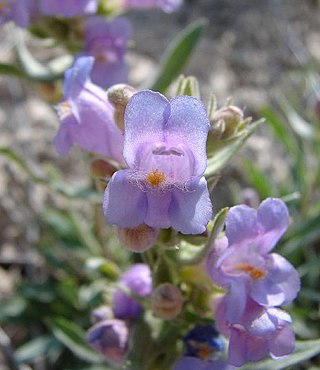
Penstemon janishiae is a species of penstemon known by the common names Antelope Valley beardtongue and Janish's beardtongue. It is native to the northwestern United States in sections of Idaho, Oregon, Nevada and northwestern California, where it is a member of the flora in sagebrush, woodland, and pine forests. It is a perennial herb with several hairy upright stems reaching up to about 25 centimeters tall. The leaves are up to 6 centimeters long, many located around the base of the plant and several pairs along each stem. The inflorescence produces several wide-mouthed tubular flowers 2 to 3 centimeters long. Each hairy, glandular flower is pale purple to pinkish or bluish in color with a dark-lined, pouchlike throat. The mouth of the flower is hairy and the protruding staminode is coated in bright orange or yellow hairs.

Penstemon papillatus is a species of penstemon known by the common name Inyo beardtongue.
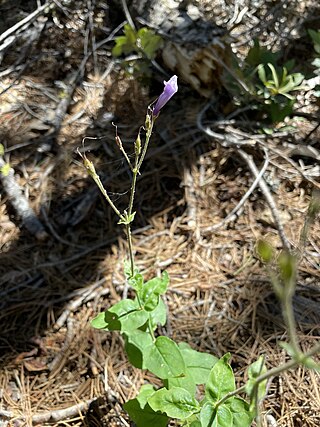
Penstemon personatus is an uncommon species of penstemon known by the common name closethroat beardtongue.

Penstemon utahensis is a species of penstemon known by the common names Utah beardtongue and Utah penstemon. It is native to the southwestern United States, where it grows in scrub, woodland, and canyons. It is a perennial herb growing erect to a maximum height near half a meter. The thick leaves are located around the base of the plant and in opposite pairs along the stem. The upper leaves are lance-shaped and often folded lengthwise, measuring up to 5.5 centimeters long. The showy inflorescence bears many bright red-pink flowers up to 2.5 centimeters in length. They are cylindrical, tubular, or funnel-shaped with wide, lobed mouths, and mostly hairless to slightly hairy and glandular.
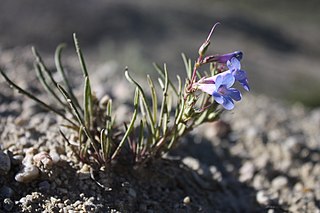
Penstemon penlandii is a rare species of flowering plant in the plantain family known by the common names Penland penstemon and Penland's beardtongue. It is endemic to Colorado in the United States, where it is known only from a strip of land about five miles long in central Grand County. There are two occurrences totalling about 8600 individuals. This is a federally listed endangered species of the United States.

Penstemon pinorum is a rare species of flowering plant in the plantain family known by the common names Pine Valley penstemon and pinyon penstemon. It is endemic to Utah in the United States, where it is known only from an area along the border between Washington and Iron Counties.

Penstemon rhizomatosus is a rare species of flowering plant in the plantain family known by the common names Scheel Creek beardtongue and rhizome beardtongue. It is endemic to Nevada in the United States, where it occurs only in the Schell Creek Range of White Pine County.
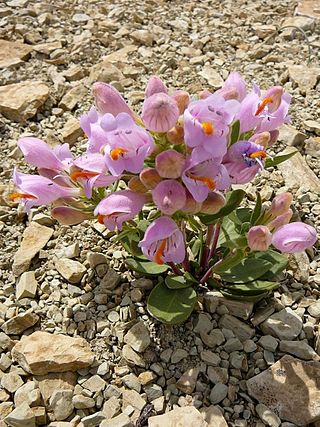
Penstemon grahamii, known by the common names Uinta Basin beardtongue and Graham's beardtongue, is a species of flowering plant in the plantain family. It is native to Utah and Colorado in the United States.
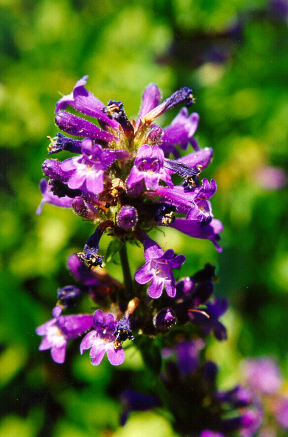
Penstemon attenuatus is a species of flowering plant in the plantain family known by the common names sulphur penstemon and taperleaf beardtongue. It is native to the northwestern United States.
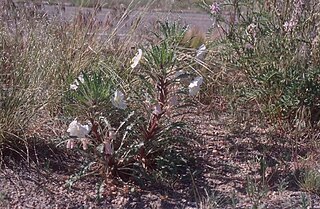
Oenothera harringtonii is a species of flowering plant in the evening primrose family known by the common names Arkansas Valley evening primrose and Colorado Springs evening primrose. It is endemic to the state of Colorado in the United States.
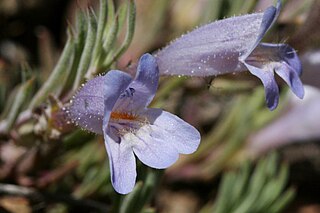
Penstemon caespitosus, commonly known as mat penstemon, is a summer blooming perennial flower in the large Penstemon genus. It is a widespread plant from near timberline to the foothills in the Southern Rocky Mountains and Colorado Plateau in North America. It is noted for its ground hugging growth habit and as a plant used in xeriscape and rock gardening.



















